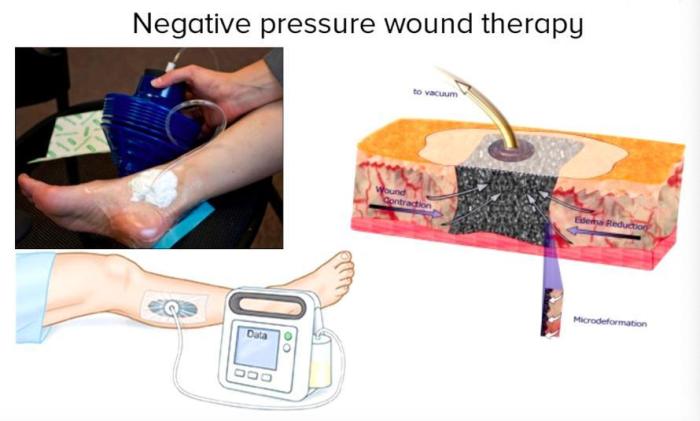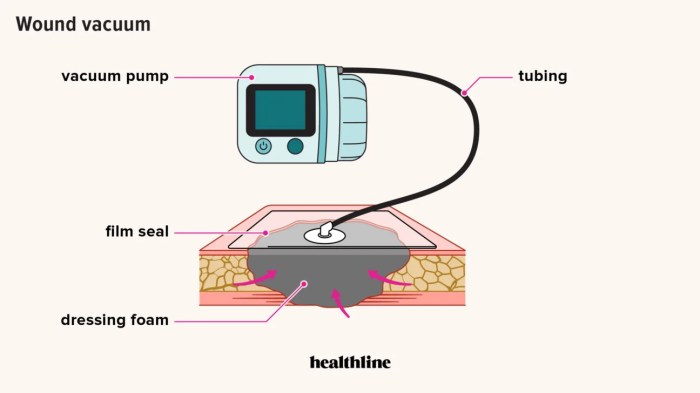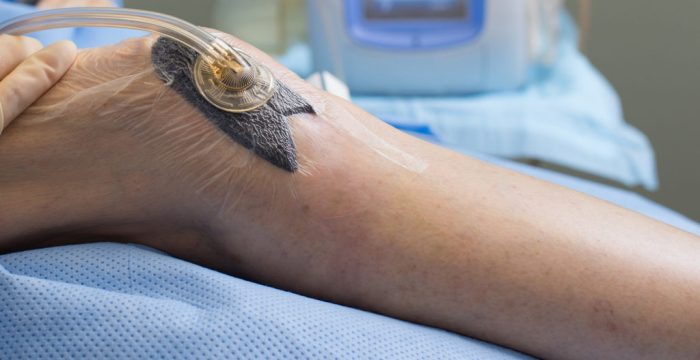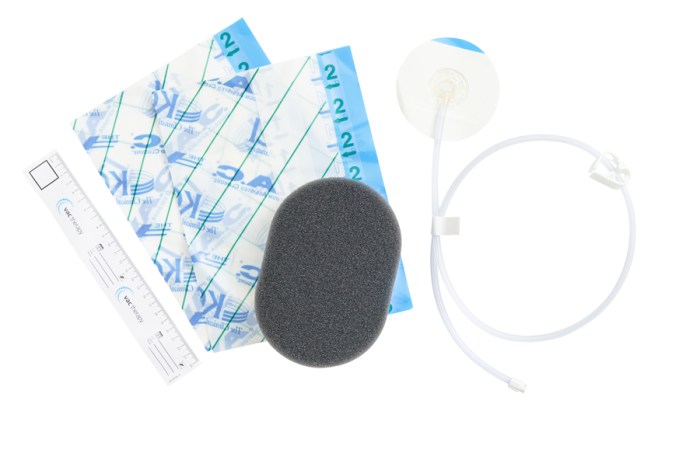Wound vac black foam on skin – Wound vac black foam has emerged as a revolutionary wound care solution, offering a multitude of benefits for wound management. Its unique properties and versatility make it an indispensable tool in the hands of healthcare professionals seeking to optimize wound healing outcomes.
This article delves into the world of wound vac black foam, exploring its types, applications, benefits, and precautions. We will also examine case studies and alternative wound care dressings to provide a comprehensive understanding of this essential wound care material.
Introduction

Wound vac black foam, also known as negative pressure wound therapy (NPWT), is a medical device used to promote wound healing. It consists of a black foam dressing that is placed over the wound and connected to a vacuum pump.
The vacuum pump creates negative pressure, which helps to draw fluid and bacteria out of the wound, promoting healing.
Role in Wound Management, Wound vac black foam on skin
Wound vac black foam is commonly used to treat chronic wounds, such as pressure ulcers, diabetic foot ulcers, and surgical wounds that are not healing properly. It can also be used to treat acute wounds, such as burns and traumatic injuries.By
removing fluid and bacteria from the wound, wound vac black foam helps to create a moist environment that is conducive to healing. It also helps to reduce pain and inflammation, and can promote the growth of new tissue.
Types of Wound Vac Black Foam

Wound vac black foam dressings are available in various types, each designed for specific wound characteristics and healing stages. Understanding the different types is crucial for selecting the most appropriate dressing for optimal wound management.
Types of Wound Vac Black Foam
- Non-Adhesive Foam:These dressings do not have an adhesive backing, allowing for easy placement and removal. They are ideal for wounds with minimal exudate and require frequent dressing changes.
- Adhesive Foam:These dressings have an adhesive backing that secures them to the wound bed. They are suitable for wounds with moderate to heavy exudate, providing a barrier against leakage.
- Silver-Infused Foam:These dressings incorporate silver ions, which possess antimicrobial properties. They are effective in preventing and treating wound infections.
- Activated Charcoal Foam:These dressings contain activated charcoal, which absorbs odors and toxins. They are beneficial for wounds with excessive drainage or foul odor.
- Foam with Border:These dressings have an absorbent foam center surrounded by a waterproof border. The border prevents leakage and protects the surrounding skin from maceration.
- Composite Foam:These dressings combine different layers of foam with varying densities. They provide optimal absorption and cushioning for wounds with complex contours or tunneling.
Benefits of Wound Vac Black Foam

Wound vac black foam offers several advantages for wound management. It promotes wound healing, reduces infection risk, and provides a comfortable environment for the wound to heal.
One of the key benefits of wound vac black foam is its ability to create a moist wound environment. This moist environment is ideal for wound healing as it promotes the growth of new tissue and helps to prevent the wound from drying out and becoming infected.
Infection Control
Wound vac black foam also helps to reduce the risk of infection by preventing bacteria from entering the wound. The foam’s closed-cell structure creates a barrier between the wound and the outside environment, which helps to keep bacteria out.
Comfort
In addition to its healing and infection-control properties, wound vac black foam is also comfortable to wear. The foam is soft and pliable, and it conforms to the shape of the wound, which helps to reduce pain and discomfort.
Application of Wound Vac Black Foam

Applying wound vac black foam is a crucial step in wound management. Proper application ensures optimal wound healing and prevents complications.
Preparing the Wound Bed:
- Cleanse the wound thoroughly with saline or an antiseptic solution.
- Debride necrotic or infected tissue as necessary.
- Dry the wound bed gently with sterile gauze.
Securing the Foam:
- Cut the foam to fit the wound size and shape.
- Place the foam gently over the wound bed, ensuring it covers the entire wound surface.
- Secure the foam with an appropriate dressing, such as a transparent film or gauze.
- Apply negative pressure to the dressing according to the manufacturer’s instructions.
Removal of Wound Vac Black Foam
Properly removing wound vac black foam is crucial to prevent damage to the wound and promote healing. The foam should be changed as directed by a healthcare professional, typically every 2-3 days.
To remove the foam, follow these steps:
- Wash your hands thoroughly with soap and water.
- Gather clean gloves, scissors, and a new piece of wound vac black foam.
- Put on the gloves.
- Use the scissors to carefully cut around the edges of the old foam, taking care not to cut the wound.
- Gently lift the old foam away from the wound.
- Inspect the wound for any signs of infection or damage.
- Apply the new foam to the wound, ensuring that it covers the entire wound surface.
- Secure the foam in place with the provided adhesive or bandage.
- Dispose of the old foam properly.
- Wash your hands again.
Precautions and Contraindications

The use of wound vac black foam, while generally safe and effective, requires certain precautions and considerations to ensure optimal patient outcomes. There are specific situations where its use may be contraindicated, and potential risks and complications should be understood before applying it to a wound.
It’s crucial for healthcare professionals to carefully assess the patient’s condition, wound characteristics, and overall health status to determine the suitability of wound vac black foam. Understanding the potential risks and contraindications associated with its use helps ensure safe and appropriate wound management.
Contraindications
- Necrotic tissue:Black foam should not be applied to wounds with significant necrotic tissue, as it can trap bacteria and impede wound healing.
- Exposed blood vessels or organs:Black foam should not be placed directly over exposed blood vessels or organs, as it can cause damage or interfere with their function.
- Active bleeding:Black foam is not suitable for wounds with active bleeding, as it can absorb blood and impede hemostasis.
- Infection:Black foam should not be used on wounds with active infection, as it can provide a moist environment that promotes bacterial growth.
- Allergic reactions:Patients with known allergies to polyurethane or other components of the black foam should not use it.
Precautions
- Monitor wound healing:Healthcare professionals should regularly monitor the wound’s healing progress and adjust the black foam dressing as needed to ensure optimal healing.
- Prevent skin maceration:Black foam can create a moist environment, which can lead to skin maceration if not managed properly. Ensure the surrounding skin is clean and dry to prevent skin breakdown.
- Manage pain:Black foam can sometimes cause discomfort or pain, especially during dressing changes. Adequate pain management strategies should be implemented to ensure patient comfort.
- Follow manufacturer’s instructions:It’s crucial to follow the manufacturer’s instructions carefully when using black foam to ensure proper application and avoid potential complications.
- Consult a healthcare professional:If any concerns or complications arise during the use of black foam, consult a healthcare professional promptly for further guidance and treatment.
Case Studies
Wound vac black foam has demonstrated promising results in various clinical applications. Here are a few case studies that highlight its effectiveness:
Successful Application in a Diabetic Foot Ulcer
A 65-year-old diabetic patient presented with a chronic foot ulcer that had failed to heal despite conventional treatments. The wound was heavily exudative and had necrotic tissue. A wound vac black foam dressing was applied, and the wound was monitored closely.
Within a week of using the wound vac black foam, the exudate level decreased significantly. The necrotic tissue gradually sloughed off, and granulation tissue began to form. The wound continued to heal steadily, and the patient was able to walk without pain within a few months.
Effectiveness in a Pressure Sore
A 90-year-old patient developed a pressure sore on their sacrum due to prolonged bed rest. The sore was deep and had become infected. A wound vac black foam dressing was applied, and the wound was treated with antibiotics.
The wound vac black foam helped to remove the infection and promote healing. The exudate level decreased, and the wound gradually filled in. The patient was able to sit up and move around without discomfort within a few weeks.
Wound vac black foam on skin is a medical treatment that can help to heal wounds. It is made of a special type of foam that is designed to absorb fluids and create a moist environment that is conducive to healing.
Wordly wise book 7 answers can provide more information about wound vac black foam on skin and other medical treatments.
Alternatives to Wound Vac Black Foam: Wound Vac Black Foam On Skin

Wound vac black foam is a highly effective wound care dressing, but it is not the only option available. In some cases, alternative dressings may be more appropriate.
Foam Dressings
- Advantages:Conformable, absorbent, and cost-effective.
- Disadvantages:May not be as effective as wound vac black foam in managing exudate.
Alginate Dressings
- Advantages:Highly absorbent, hemostatic, and can be used on heavily exuding wounds.
- Disadvantages:Can be difficult to remove, may cause irritation.
Hydrocolloid Dressings
- Advantages:Conformable, occlusive, and can promote wound healing.
- Disadvantages:May not be suitable for heavily exuding wounds, can be expensive.
Negative Pressure Wound Therapy (NPWT)
- Advantages:Can effectively manage heavily exuding wounds, promotes wound healing.
- Disadvantages:Requires specialized equipment, can be expensive.
The best alternative dressing for a particular wound will depend on the individual patient and the specific wound characteristics. It is important to consult with a healthcare professional to determine the most appropriate dressing for each wound.
Answers to Common Questions
What is wound vac black foam?
Wound vac black foam is a type of wound dressing made from a soft, absorbent material that is placed directly on the wound bed. It is typically used in conjunction with a vacuum-assisted closure (VAC) device, which creates negative pressure to help draw fluids and promote wound healing.
What are the benefits of using wound vac black foam?
Wound vac black foam offers a number of benefits, including:
- Promotes wound healing by creating a moist environment that facilitates cell growth and tissue regeneration.
- Reduces infection risk by preventing bacteria and other microorganisms from entering the wound.
- Helps to remove excess fluids and exudate from the wound, which can help to prevent maceration and promote healing.
- Provides a protective barrier over the wound, which can help to reduce pain and discomfort.
How is wound vac black foam applied?
Wound vac black foam is typically applied by a healthcare professional. The wound bed is first prepared by cleaning and debriding the wound. The foam is then cut to size and placed directly on the wound bed. A VAC device is then attached to the foam and negative pressure is applied.
The foam is typically changed every 2-3 days.
What are the precautions and contraindications for using wound vac black foam?
Wound vac black foam is generally safe and well-tolerated. However, there are some precautions and contraindications to be aware of:
- Wound vac black foam should not be used on wounds that are infected or have exposed bone or tendons.
- Wound vac black foam should not be used on patients who have a history of deep vein thrombosis (DVT) or pulmonary embolism (PE).
- Wound vac black foam should not be used on patients who are taking anticoagulants.